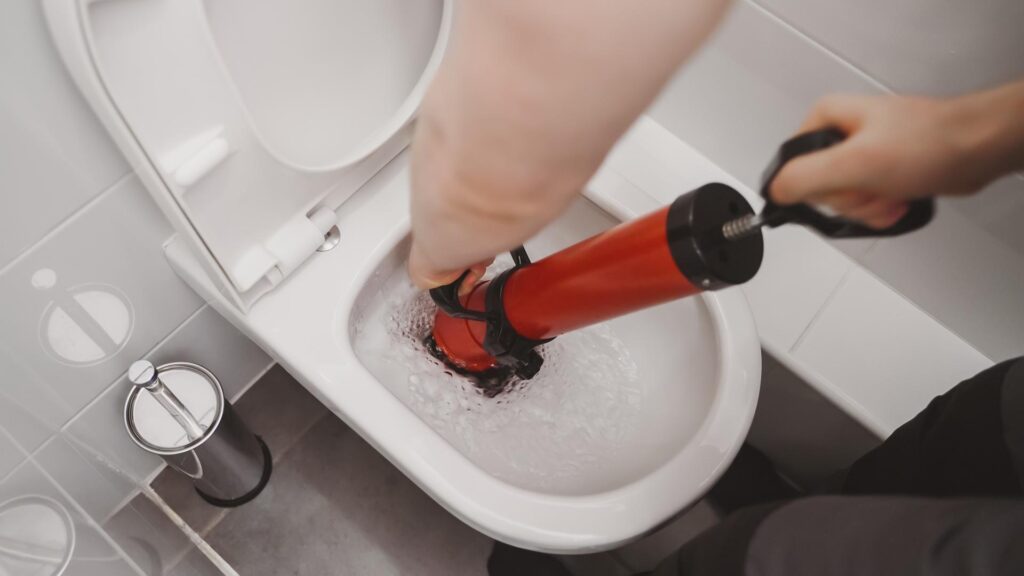
Contents
When faced with a sewage backup, you might wonder how such an issue could happen in your home. It’s a distressing situation that can leave you feeling overwhelmed. Understanding the cleanup process is vital for your safety and peace of mind. What steps should you take immediately? And how can you ensure it doesn’t happen again? These questions are essential as you navigate the aftermath of a sewage backup.
Key Takeaways
- Identify sewage backups by noticing unusual odors, slow drains, or gurgling sounds from pipes.
- Prioritize safety by evacuating the area and shutting off electricity before cleanup.
- Contact local sewage authorities and professional services for immediate assistance and cleanup.
- Wear protective gear, ventilate the space, and isolate affected zones during cleanup.
- Document damage for insurance claims and ensure thorough disinfection to prevent health risks.
What Causes Sewage Backups in Homes?
When you experience a sewage backup at home, it’s often due to a combination of factors that can disrupt the flow of wastewater. Common culprits include drainage issues like clogged pipes or blockages from foreign objects, which can impede the system’s functionality.
Tree roots infiltrating your plumbing can also cause significant disruptions, leading to backups that can be both inconvenient and distressing.
Regular plumbing maintenance is essential for preventing these problems. By scheduling routine inspections and cleanings, you can identify potential issues before they escalate.
It’s important to remain vigilant—taking proactive steps can save you from costly repairs and the stress of dealing with a backup.
How Can I Identify a Sewage Backup?
How can you tell if a sewage backup is occurring in your home? Start by noticing any unusual sewage odors; effective sewage odor detection is essential in identifying a problem. If you smell something foul, it’s a sign that wastewater might be backing up.
Also, pay attention to slow drains or multiple fixtures backing up simultaneously, as these are common indicators. You might want to conduct plumbing inspections, focusing on areas like toilets, sinks, and floor drains.
Look for visible signs, such as water pooling in unexpected places or rising toilet bowls. If you experience gurgling sounds from your pipes, that could signal a blockage.
What Should I Do Immediately After a Sewage Backup?
Experiencing a sewage backup can be overwhelming, but knowing what steps to take immediately can help mitigate damage and assure safety.
First, prioritize your safety—avoid the affected area and make sure everyone evacuates. Shut off the electricity in that part of your home to prevent accidents.
Next, reach out to emergency contacts, including your local sewage authority and a professional cleanup service. They’re equipped to handle hazardous situations like this and can guide you through the process.
Document the damage with photos for insurance claims, but don’t attempt to clean up the mess yourself, as harmful bacteria may be present.
If you have flood insurance, notify your provider right away.
How Is Sewage Backup Cleanup Performed?
Although sewage backup cleanup can seem intimidating, understanding the process can help ease your concerns.
First, professionals assess the affected area to determine the extent of the damage. They’ll isolate the contaminated space, ensuring safety before starting any sewage treatment.
Next, they employ specialized cleanup methods, such as water extraction, to remove standing sewage and water.
Once the bulk of the waste is cleared, they’ll disinfect surfaces using industrial-grade cleaners to eliminate pathogens.
Afterward, they’ll thoroughly dry the area to prevent mold growth, utilizing fans and dehumidifiers. If necessary, damaged materials like carpets or drywall may be removed and replaced to restore your home.
Finally, professionals conduct a follow-up inspection to ensure the area is safe and clean.
What Safety Precautions Should Be Taken During Cleanup?
When dealing with sewage backup cleanup, it’s essential to prioritize your safety by wearing appropriate protective gear, such as gloves, masks, and waterproof boots.
You also need to take specific precautions in the contaminated area to prevent exposure to harmful pathogens.
Understanding these safety measures will help ensure a safer and more efficient cleanup process.
Protective Gear Requirements
To ensure your safety during sewage backup cleanup, it’s essential to wear proper protective gear. Start with durable protective clothing, such as long-sleeved shirts and pants, to shield your skin from contaminants.
Waterproof boots are a must to keep your feet dry and protected. Don’t forget to wear safety goggles; they’ll prevent splashes from entering your eyes, which can lead to serious health issues.
Additionally, consider using gloves made from materials like nitrile or rubber, as they offer a barrier against harmful pathogens. These precautions safeguard your health and provide peace of mind.
Contaminated Area Precautions
Ensuring safety during the cleanup of a contaminated area is essential, as exposure to sewage can pose serious health risks. You must prioritize contamination control and area isolation to protect yourself and your loved ones.
| Precaution | Description |
|---|---|
| Wear Protective Gear | Use gloves, masks, and boots to shield against pathogens. |
| Ventilate the Area | Open windows and doors to improve air circulation. |
| Isolate Affected Zones | Seal off contaminated spaces to avoid spreading toxins. |
| Dispose of Waste Properly | Use sealed bags for safe disposal of contaminated materials. |
How Can I Prevent Future Sewage Backups?
To prevent future sewage backups, it’s essential to schedule regular maintenance checks of your plumbing system.
Additionally, adopting proper waste disposal practices can greatly reduce the risk of clogs and blockages.
Regular Maintenance Checks
Regular maintenance checks are essential for preventing future sewage backups, as they allow you to identify potential issues before they escalate.
By prioritizing drain maintenance and scheduling regular plumbing inspections, you can protect your home and your peace of mind.
Here are four key steps to follow:
- Inspect drains for clogs or slow drainage regularly.
- Schedule plumbing inspections at least once a year with a qualified professional.
- Clean your gutters and downspouts to prevent water from pooling near your foundation.
- Monitor your water bill for sudden increases, which may indicate leaks.
Proper Waste Disposal
Proper waste disposal plays an important role in preventing future sewage backups. By practicing effective waste management, you can greatly reduce the risk of clogs.
Always use proper disposal methods for items like wipes, grease, and food scraps. Instead of flushing non-biodegradable products, dispose of them in the trash.
Regularly maintain your plumbing system by avoiding harsh chemicals that can damage pipes and opting for enzymatic cleaners that promote healthy drainage.
Educate your family about what can and can’t go down the drain, fostering a shared responsibility for your home’s plumbing.
When Should I Call a Professional for Help?
When faced with a sewage backup, how do you know when it’s time to call in the experts? It’s essential to prioritize both your safety and your home’s integrity.
Here are four key situations where professional assistance is necessary:
Health Risks: If there’s potential exposure to hazardous waste, don’t hesitate to seek help.
The extent of Damage: If the backup affects multiple areas or exceeds a small spill, it’s time for emergency response.
Persistent Issues: If you’ve dealt with multiple backups, underlying plumbing issues may need professional evaluation.
Complex Cleanup: If the situation involves extensive cleanup or contaminated materials, you’ll want trained experts.
Knowing when to call for professional help can save you time, stress, and potential health risks.
Trust your instincts—seeking assistance is a smart choice when dealing with sewage backups. You’re not alone in this; support is available.
Review
Tackling a sewage backup can feel like trying to swim through molasses, but being informed empowers you to act decisively. Remember to prioritize safety, assess the situation, and document the damage for insurance purposes. While some homeowners may choose to handle cleanup themselves, calling in professionals ensures a thorough job and peace of mind. By understanding the process and taking preventive measures, you can protect your home and family from future backups.
Recent Posts
7 Best Tips for Sewage Backup Cleanup
When faced with an unfortunate plumbing mishap, it’s essential to tackle the situation with a
Effective Sewage Backup Cleanup for Homes
When a sewage backup occurs in your home, acting quickly is fundamental. You need to
Why Choose 24/7 Flood Damage Cleanup Experts?
When flood damage strikes, you need immediate help from experts who understand the urgency of
